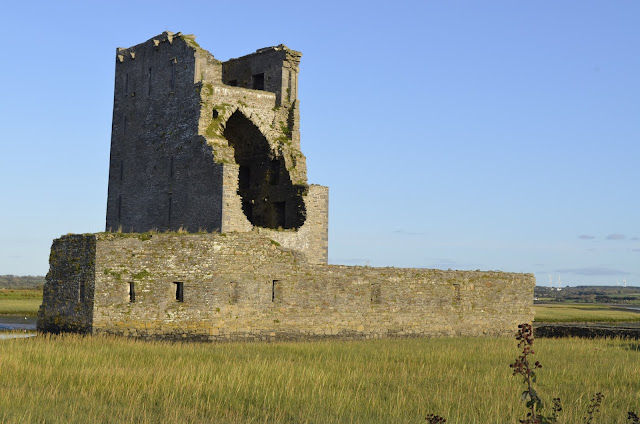Carrig Island, Ballylongford, Co. Kerry, Ireland
Carrigfoyle Castle. The view from this site is excellent. The surrounding land is pastureland, marsh and water.
The Ballylongford Heritage Trail consist of two Trails which will introduce you to sites near the village of Ballylongford and district. Carrigafoyle Castle 15th Century, Lislaughtin Abbey 15h Century, Carrig Island 6th Century, Carrig Island Napoleonic Battery Fortress 19th Century.
Carrigafoyle Castle was built between c1500 by Connor Liath O’Connor using a design borrowed from the Normans, it features a spiral staircase of 104 steps that visitors can climb.
Carrig Island Monastic Site
Dating from the sixth century, an early Christian church and settlement that was connected with the major monastery of St Senan on Scattery Island, stood within the lios or large circular earthen-work enclosure. Within the site is a Well called the Friars’ Holy Well. The remains of a stone church, nave, tower, staircase, chancel and sanctuary dating from the medieval period, possibly 13th century, are still standing, was occupied by the Canons Regular of St. Augustine until 1580
The main building of the battery which was constructed of dressed stone still intact.
The date is probably early 19th century.
Nearby is the 15th-century Carrigafoyle Castle.
Aghavallin churchyard of Ballylongford, dates from the 14th century. Church Now in ruin, at different times it served Catholic and later Church of Ireland. Graves include Sandes, Pope, Hanrahan, Moore, Mahony, Flavin and hundreds more.
The Alley
by John Fitzgerald
Standing on the dead line
I face the pockmarked wall,
it hides the bridge above me
fond memories I recall,
the side walls mark the theatre,
the concrete floor the stage,
four players take their places
the finest of their age.
The cocker’s hopped and hardened,
Junior’s feet fix solidly
he contemplates the angle
of the first trajectory.
His swinging arm begins the game
the ball’s hit low and fast,
a signal to John Joe and Tom
this will be no soft match.
Dermot standing by his side
sees his neighbour win first toss,
a simple game to twenty one
no ace is easily lost.
I watch them from the grassy mound
behind the dead ball line
hear the cries of older boys
cheer each one at a time
and in the space of half an hour
the ball has weaved its way
through every nook and cranny
in this battlefield of play,
the long ball to the back line
the close one to the wall
the deadly butted killer
seemed to hit no wall at all
and in end the four of them
take leave just as they came
and beckon us to take our place
and learn more of their game,
the game that gave such pleasure
the game I got to know.
when I was young and full of fun
in the Alley years ago.
>>>>>>
I asked Junior Griffin once who won the handball match. He told me that there were no winners or losers because as soon as you won one game you were challenged to a rematch.
There was usually a little wager on the game. Money was scarce enough so the bet was small but once Junior was on the winning side of a 2/6 (a half crown) bet. He went double or quits until the money was astronomical, and no body had any hope of paying it.
In those days the glory of winning was everything. People did not expect medals or trophies. They were happy just to win.








No comments:
Post a Comment